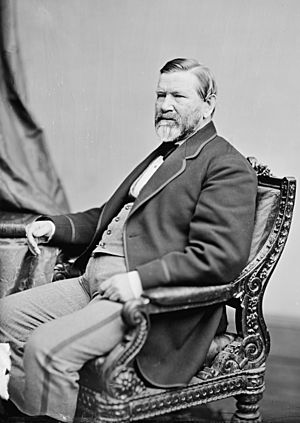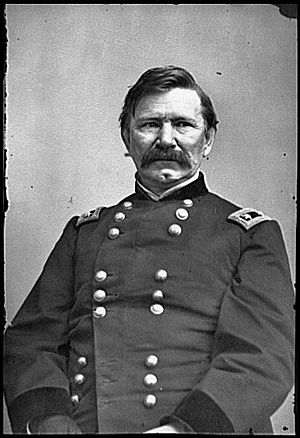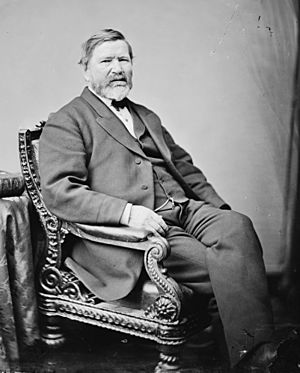Robert C. Schenck facts for kids
Quick facts for kids
Robert C. Schenck
|
|
|---|---|
 |
|
| United States Minister to Great Britain | |
| In office June 23, 1871 – March 3, 1876 |
|
| President | Ulysses S. Grant |
| Preceded by | John Lothrop Motley |
| Succeeded by | Edwards Pierrepont |
| Chairman of the House Republican Conference | |
| In office March 4, 1869 – March 3, 1871 Serving with Nathaniel P. Banks
|
|
| Speaker | James G. Blaine |
| Preceded by | Justin S. Morrill (1867) |
| Succeeded by | Austin Blair |
| Member of the U.S. House of Representatives from Ohio's 3rd district |
|
| In office March 4, 1863 – January 5, 1871 |
|
| Preceded by | Clement Vallandigham |
| Succeeded by | Lewis D. Campbell |
| In office March 4, 1843 – March 3, 1851 |
|
| Preceded by | Patrick Gaines Goode |
| Succeeded by | Hiram Bell |
| United States Minister to Brazil | |
| In office August 9, 1851 – October 8, 1853 |
|
| President | Millard Fillmore Franklin Pierce |
| Preceded by | David Tod |
| Succeeded by | William Trousdale |
| Member of the Ohio House of Representatives from Montgomery | |
| In office December 6, 1841 – March 4, 1843 |
|
| Succeeded by | Henry S. Gunckel |
| Personal details | |
| Born |
Robert Cumming Schenck
October 4, 1809 Franklin, Ohio, U.S. |
| Died | March 23, 1890 (aged 80) Washington, D.C., U.S. |
| Resting place | Woodland Cemetery, Dayton, Ohio |
| Political party | Whig Republican |
| Spouse | Renelsche Smith |
| Alma mater | Miami University |
| Military service | |
| Allegiance | United States of America |
| Branch/service | Union Army |
| Years of service | 1861–1863 |
| Rank | |
| Commands | VIII Corps |
| Battles/wars | American Civil War |
Robert Cumming Schenck (born October 4, 1809 – died March 23, 1890) was an important figure in American history. He was a Union Army general during the American Civil War. He also served as a diplomat, representing the United States in Brazil and the United Kingdom.
Schenck fought in key battles like the First and Second Battles of Bull Run. He also took part in Jackson's Valley Campaign in 1862 and the Battle of Cross Keys. His older brother, James F. Schenck, was a rear admiral in the United States Navy.
Contents
Early Life and Career
Schenck was born in Franklin, Ohio, in 1809. His parents were William Cortenus Schenck and Elizabeth Rogers. His father, William, came from a well-known Dutch family. William was a land investor and an early settler in Ohio. He also fought in the War of 1812 and became a general, just like his son Robert.
Robert's father died when Robert was only twelve. After that, General James Findlay became his guardian.
Education and Law Career
In 1824, Robert Schenck started at Miami University. He graduated with honors in 1827. He stayed in Oxford, Ohio, studying and working as a tutor for French and Latin until 1830. Then, he earned his Master of Arts degree.
He began studying law with Thomas Corwin. In 1831, he became a lawyer. He moved to Dayton, Ohio, and became a very successful lawyer there. He worked with Joseph Halsey Crane in a law firm called Crane and Schenck for many years.
On August 21, 1834, Schenck married Renelsche W. Smith. They had six daughters, but sadly, three of them died when they were babies. Three daughters lived to adulthood. His wife passed away in 1849.
Entering Politics
Schenck first tried to enter politics in 1838 but didn't win. However, he was elected to the State Legislature in 1841. During the 1840 Presidential campaign, he became known as a very skilled speaker for the Whig Party.
He was elected to the United States Congress in 1843. He was re-elected in 1845, 1847, and 1849. In 1847, he led the Committee on Roads and Canals. One of his first important actions was helping to remove a rule that stopped people from discussing anti-slavery ideas in the House. He believed the Mexican–American War was wrong because it was fought to expand slavery.
In 1851, he chose not to run for re-election. In March 1851, President Millard Fillmore appointed him as the U.S. Minister to Brazil. He also worked with Uruguay, Argentine Confederation, and Paraguay. His job was to visit these countries and create treaties. He successfully made several treaties that gave the United States advantages. However, a change in the U.S. government meant one treaty with Uruguay was not approved.
Schenck returned to Ohio in 1854. He generally agreed with the Republican Party's ideas. He was also the President of the Fort Wayne Western Railroad Company. In 1859, he gave a speech in Dayton about the growing tensions in the country. In this speech, he suggested that the Republican Party should choose Abraham Lincoln as their presidential candidate. This was one of the first public times Lincoln was supported for president. Schenck strongly supported Lincoln in the 1860 election campaign.
Civil War Service
When the attack on Fort Sumter happened, Schenck immediately offered to help President Lincoln. He later remembered their meeting:
"Lincoln asked me, 'Schenck, what can you do to help me?' I said, 'Anything you want.' He asked, 'Can you fight?' I replied, 'I would try.' Lincoln then said, 'I want to make you a general.' I answered, 'I don't know about that, Mr. President, you could appoint me, but I might not prove to be one.' Then he did, and I went to war."
Schenck became a brigadier general of volunteers. Even though he wasn't a trained military man, he had studied military science carefully.
Battle of Vienna, Virginia
On June 17, 1861, Schenck was in command of the 1st Ohio Volunteer Infantry Regiment. They were sent to expand the Union's position in Fairfax County, Virginia. Schenck and his men were on a train near Vienna, Virginia. A Confederate force, led by Colonel Maxcy Gregg, set up cannons near the railroad tracks.
An older local man tried to warn the Union soldiers about the hidden Confederates, but his warning was mostly ignored. As the train rounded a curve, the Confederates fired their cannons. The Union soldiers quickly jumped from the train and sought cover. Schenck ordered the train to back away. The Union force had some soldiers killed and wounded. The Confederates took supplies and burned some train cars. This event showed the Union officers needed to be more careful.
First Battle of Bull Run
Schenck's next major action was at the First Battle of Bull Run on July 21, 1861. He commanded a brigade in General Daniel Tyler's division. When the battle turned against the Union, many units fled. However, parts of Schenck's brigade, along with other units, left the battlefield in a more organized way.
Later Campaigns and Injury
Schenck later served under Major General William Rosecrans in West Virginia. He also served under Major General John C. Fremont in the Luray Valley. He took part in the Jackson's Valley Campaign of 1862 in the Shenandoah Valley. He was also at the Battle of Cross Keys. For a time, he commanded the I Corps.
He then joined the Army of Virginia just before the Second Battle of Bull Run. He was heavily involved in the fighting over two days. On the second day, he was badly wounded, and his right arm was permanently injured. He was promoted to major general on September 18, 1862.
Schenck could not fight in the field for six months because of his injury. He was then put in charge of the VIII Corps in Maryland. His job was to keep order and stop any actions against the Union. He was not popular with people in Maryland who supported the Confederacy. In December 1863, he left his military role to return to Congress.
After the War
Schenck was elected to Congress from Ohio, defeating Clement Vallandigham. He quickly became the leader of the House Committee on Military Affairs. He was known for supporting volunteer soldiers and being tough on those who deserted. He also strongly supported the draft to get more soldiers.
He was re-elected to Congress several times. He was a leader in the House, even serving as Chairman of the Ways and Means Committee, which handles money matters.
Diplomat to the United Kingdom
After losing re-election by a small number of votes in 1870, President Ulysses S. Grant appointed Schenck as the U.S. Minister to the United Kingdom. He traveled to England in July 1871.
As part of the Alabama Claims Commission, he helped settle disagreements related to the actions of the Confederate ship CSS Alabama.
While in England, Schenck became famous for something unexpected: poker. At a party hosted by Queen Victoria, a duchess asked him to write down his rules for poker. She then had these rules printed for her court. This was the first book published about "draw poker" on either side of the Atlantic. The game quickly became popular in England and was known as "Schenck's poker."
In 1871, Schenck was involved in a business deal related to the Emma Silver Mine in Utah. He was paid to let his name be used to sell stock in England and became a director of the mining company. Many British people invested because they saw the American minister's name connected to it. The mine paid large profits for a short time, but then the stock prices crashed when it was found that the mine was empty. Schenck was blamed and was called back to the U.S. for an investigation. He resigned from his diplomatic post in 1875. A congressional investigation in 1876 found that he had not done anything wrong, but he had shown poor judgment by linking his name to the business.
After returning from England, he continued his law practice in Washington, D.C. He also published his poker rule book, Draw. Rules for Playing Poker, in 1880. Schenck was a very knowledgeable person, skilled in law, political history, and literature.
Robert C. Schenck passed away in Washington, D.C., on March 23, 1890, at the age of 80. He was buried in Woodland Cemetery, Dayton, Ohio.
Images for kids



